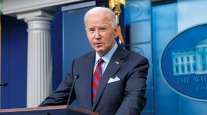Ohio DOT Chief Paints Dire Picture of State’s Infrastructure Funding

The state transportation director gave Ohio lawmakers a blunt assessment of Ohio’s road construction money situation Feb. 13, and it wasn’t pretty.
“We are facing a future where we will clearly not be able to maintain the quality of the system we have, let alone improve upon it,” Jack Marchbanks, head of the Ohio Department of Transportation, told the House Finance Committee.
“Past practices of borrowing and bonding have brought us to this troubled state, and we are here because we need a better solution. Without one, our system of state and local roadways will fall into a dangerous state of disrepair.”
While lawmakers are awaiting Gov. Mike DeWine’s introduction of the new two-year transportation budget, House Republicans kicked off hearings on the spending bill, which under Ohio law must be passed and signed into law by the end of March.
DeWine has not indicated when he will introduce his plan, but a committee he formed to make recommendations on additional road and bridge revenue is expected to issue a report Feb. 15. That report is likely to recommend a higher gas tax.
DeWine’s transportation director made it clear that, whether it’s a gas tax increase or something else, without new revenue, Ohio is “looking over the edge of a fiscal cliff.”
Ohio’s 28-cents-per-gallon gas tax was last increased in 2005, and Marchbanks said a dollar from 2003 is now worth just 58 cents because of inflation. Gas tax revenue, he said, has remained relatively flat over 15 years, and Ohio has gotten by for the past five years thanks largely to $1.5 billion raised through bonding against future turnpike tolls.

Ohio Department of Transportation
That turnpike money is now accounted for, leaving no money for major new road construction projects, such as certain phases of the Interstate 71/I-70 interchange. The state, Marchbanks said, also kicked $150 million in maintenance work set for next fiscal year into the future to balance the budget.
“Beginning July 1, there is no state money for any new roadway projects in Ohio,” Marchbanks said. “There is no state money to address congestion in urban areas. We will be less able to fix dangerous intersections. Roadways will crumble, making driving dangerous. And, there will be no state money for projects that might help a local government attract economic development to their area.”
Asked by Rep. Mark Romanchuk (R-Mansfield) how much he needs and where it should come from, Marchbanks declined to recommend a revenue source. He said the department is about $1 billion short on revenue.
A gas tax increase would raise about $67 million per penny each year.
“I’d be curious to hear from this administration where they think the revenue is going to come from,” Romanchuk said.
Marchbanks stressed that, whatever revenue options are discussed, they should not include additional debt. The state already is paying a hefty debt load, he said — $390 million this year, largely because of prior borrowing against future gas tax revenue and turnpike bonding.
That is money, he said, that could be used to fund dozens of projects but instead is essentially going for prior projects.
“Instead of increasing that revenue stream, the state has been taking on more and more debt to complete projects and maintain the status quo,” Marchbanks said. “Today, this has pancaked into a situation that is irresponsible to continue.”
Local governments and regional planning commissions also are feeling the impact of the funding crunch, Marchbanks said.
“I am not exaggerating when I tell you that additional delayed maintenance of these already poor roads and bridges could quickly create a situation from which county and municipal governments may never financially recover,” he said.
Distributed by Tribune Content Agency, LLC




